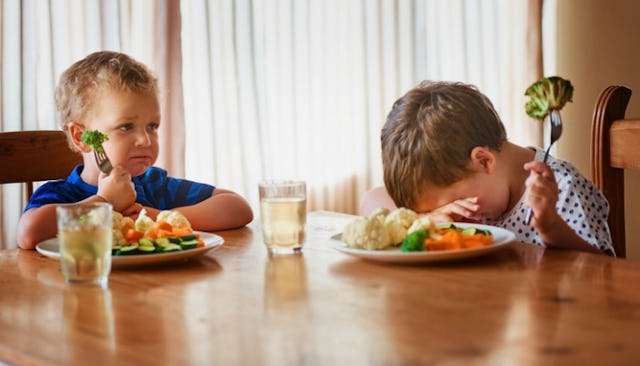Oops! It Turns Out We Should Probably Stop Tricking Our Kids Into Eating Vegetables

I don’t think I’m alone when I say that feeding kids can be a royal pain in the butt. Their toast needs to be cut a certain way, or it will be dead to them. God forbid a tiny piece of bagel is burnt, or their pizza has a smidge of green on it. And if you give them juice in the wrong cup? Call 911 because we’ve got an emergency.
And forget about a balanced diet. If it were up to my kids, they would eat nothing but bread, cheese, and chocolate kisses. It turns out I’m not alone. According to the CDC, 60% of kids ages 1 to 18 did not meet the U.S. Department of Agriculture Food Patterns criteria for adequate fruit intake, and a startling 93 % did not meet the criteria for vegetable intake.
So, yeah. You’re not alone if your kid won’t come within 10 feet of a head of broccoli.
But we all love our kids and don’t want them to turn green from malnutrition (this actually happened to my grandmother when she was a kid, before bread and cereal were fortified and gummy vitamins were all the rage). So we figure out ways to get their fruits and vegetables into them. My kids have never been fans of those veggie pouches or the fruit/grain yogurt blends. But they go crazy for a banana/peanut butter smoothie and don’t even care if I throw a handful of spinach in. I’ve been known to bake spinach into muffins and throw veggies into omelets like a boss.
Well, according to some experts on the subject, I (and probably you too) have been doing it all wrong. According to a recent NPR article, the way for kids to form good eating habits is for them to actually eat the fruits and vegetables, in their original form — no mashing up or disguising. Gillian Harris, a clinical psychologist and expert on picky eating from the University of Birmingham in the U.K., explains it like this: “You want the child to look at the vegetable, taste the vegetable, get used to the vegetable, and eat that vegetable when they’re 7 or 8.”
Well, geez. She does have a point there. You can’t be blending up vegetables for your kid until they go to college. The experts who weighed in said that kids need to get used to the textures, smells, and real-life feel of the vegetables for long-term healthy eating and good overall health. Lucy Cooke, a psychologist at University College London, tells NPR that the single most effective way to do this is through repeated exposure. “Nobody has come up with anything that works better than mere exposure,” Cooke explains.
And the research proves this too. A study conducted by Cooke, and published in the Journal of Human Nutrition and Dietetics backs up the claim that children need to become familiar with a food in order to accept it and eat it and that kids need to try a food at least 8 t0 15 times before they can know whether they like it or not.
Eight to fifteen times? In theory, that sounds great. But who the hell has the time or the patience to get their kid to try something that many times (and clean up the mess they make when they spit it out all over the floor)?
Cooke has developed an interesting program for picky eaters that she calls Tiny Tastes, where pea-sized amounts of vegetables are offered to kids. The kids are given stickers if they try the food, but are not reprimanded if they don’t. The “tastes” are offered outside of mealtimes, so there is less pressure. Cooke tells NPR that she has seen amazing results with her program, with kids who went through the program eating more of that particular vegetables three months later.
Perhaps even more promising (and maybe less messy and time-consuming) is a brand-new study showing that kids are more likely to eat their vegetables if you let them play with them. The researchers gave preschool kids “sensory play” time with their vegetables and found these kids were more likely to eat the vegetables at mealtime. The kids who played with crafts, or who watched adults handle their vegetables, were less likely to eat the vegetables later on.
I guess the bottom line is that kids need to get up close and personal with their vegetables — and perhaps have an extended period of getting to know them. I like all of this in theory, but as a parent of a couple finicky eaters, I don’t see all of this working as flawlessly as these experts lay out.
I have one kid in particular who is a truly stubborn picky eater, and he has seen through all the games and tricks I have tried to get him to eat differently. None of the techniques laid out here would work for him. And really, if he is happy to suck down a green smoothie a couple times a week, I don’t think that’s necessarily a bad thing.
However, if you take a long-term look at nutrition, I can see for sure that kids need to eventually eat their veggies the traditional way, and disguising them for too long doesn’t do anyone good. Still, I think we all need to take advice like this with a grain of salt (no pun intended), and just figure out what works best for our families when it comes to eating, nutrition — and our sanity.